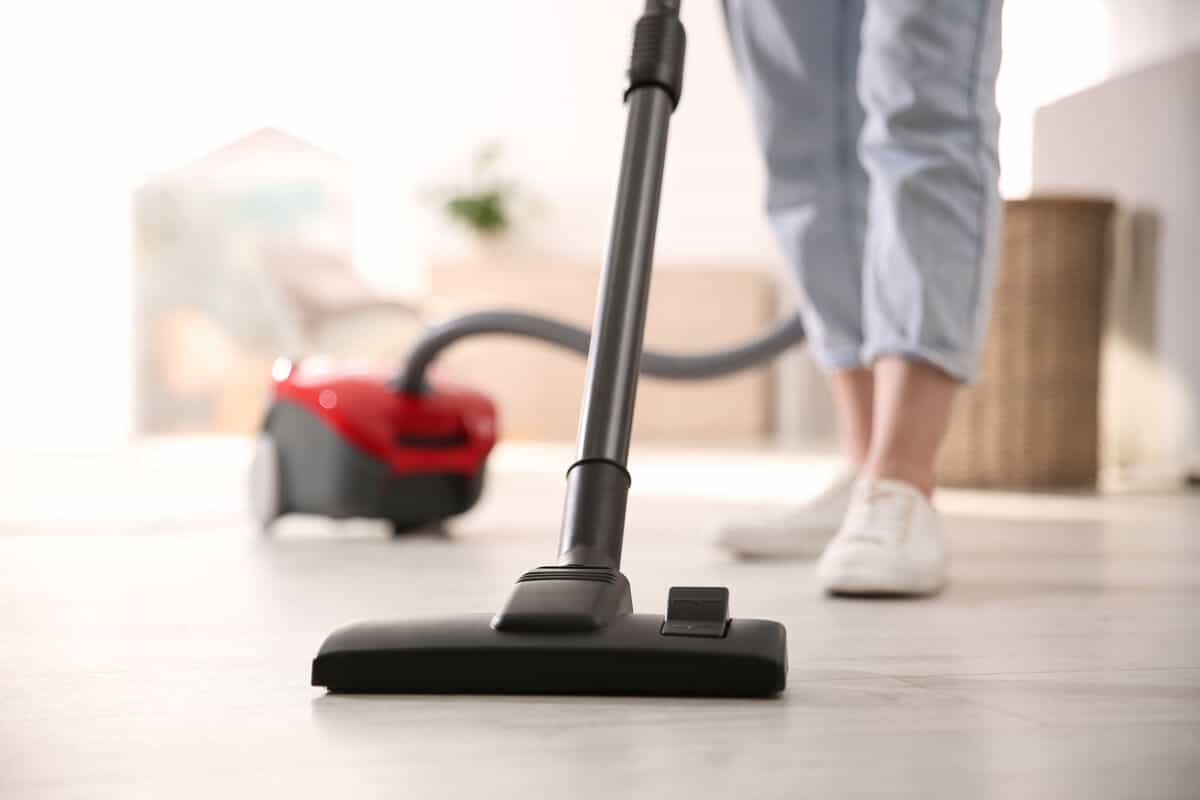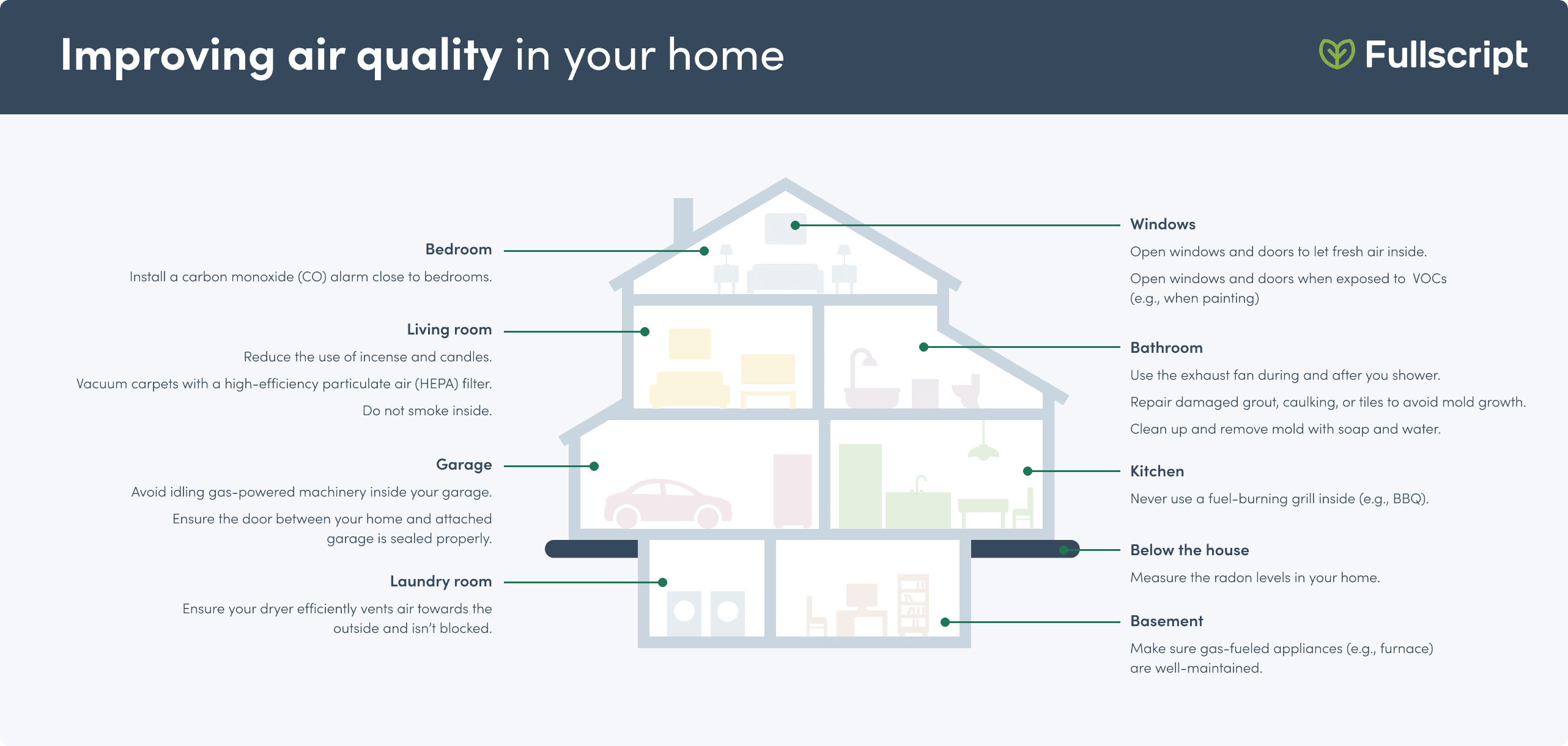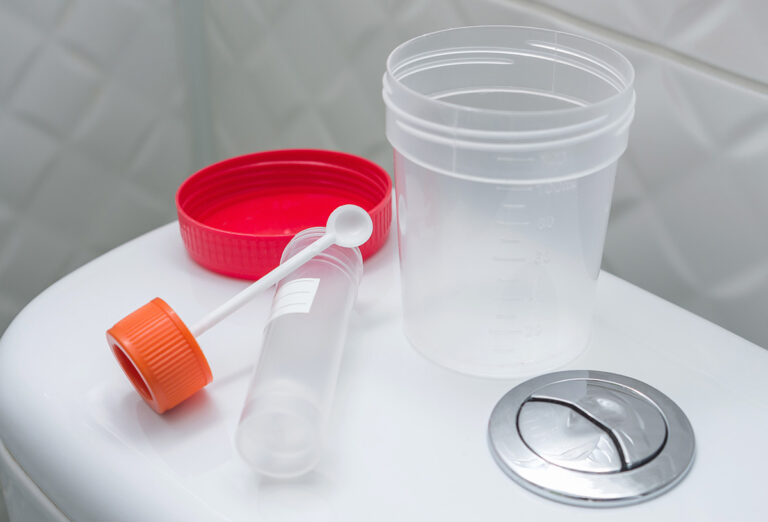Why is indoor air quality important?
Indoor air quality refers to the quality of air in a home, workplace, school, or other building. (22) It’s important to consider indoor air quality because it can have widespread effects on your health. (22) Indoor air pollutants can irritate the eyes, nose, and throat, and may cause headaches, dizziness, and fatigue. (25) Long-term exposure to certain indoor air pollutants may also lead to respiratory diseases, heart disease, and certain cancers. (25) Individuals with existing health conditions such as asthma or those who experience allergies may be particularly sensitive to indoor air pollution. (25)Did you know? Research indicates that indoor air is often more polluted than outdoor air. (22)
Common types of indoor air pollutants
Indoor air pollutants predominantly originate from inside a house or building. Although indoor air pollutants can be minimized, many homes contain more than one source and the accumulation of these pollutants can negatively affect our health and contribute to unhealthy air quality.Carbon monoxide
Carbon monoxide (CO) is an odorless, colorless, and tasteless gas produced during combustion reactions. (7) CO is emitted from burning cigarettes, fireplaces, wood and gas stoves, furnaces, gas water heaters, cars, barbecues, and other commonly used household items. CO is harmful to health, and exposure to low concentrations can cause dizziness, headaches, and chest pain. (7) High concentrations of CO can lead to loss of consciousness and potentially death. (7)Biological contaminants
Biological contaminants are microorganisms, such as bacteria, viruses, fungi, and parasites that infiltrate indoor environments. Examples include animal dander, cat saliva, dust mites, pollen, mold, and mildew. (1) These contaminants can aggravate asthma symptoms and cause sneezing, coughing, dizziness, and fever. (1) Mold, specifically, can develop on surfaces exposed to moisture, such as carpets, ceilings, and furniture. Several factors may contribute to mold growth, including:- Flooding
- Leaking roof or pipes
- Sewage backup
- Standing water
- Water-damaged materials
- Wet surfaces
Radon
Radon is a naturally occurring odorless radioactive gas that’s emitted from bedrock located underneath a house or building. Radon forms when the uranium that’s present in rocks and soil breaks down. This gas, which can become trapped inside buildings after entering through cracks, is a human carcinogen and the second leading contributor to lung cancer. (22)(24)Volatile organic compounds
Volatile organic compounds (VOCs) are gases emitted from different solids or liquids and encompass a variety of different pollutants such as benzene and acetaldehyde. (4)(12) Paints, varnishes, wax, adhesives, gas, kerosene, and sealants all emit VOCs. (9) Household cleaning products and many personal care products also emit VOCs. (9) A systematic review that examined hazardous substances present in 105 common cleaning products in Switzerland found that 75% of the products contained chemicals that were considered irritants, and over 50% of the products were considered harmful or hazardous when ingested or exposed to the eyes and skin. (3) VOCs are also emitted from furniture, air fresheners, electronics, and children’s toys. Plug-in air fresheners contain hundreds of chemicals and when released into the air, can form VOCs. (18) Some states such as California, Washington, and Maine have advocated for more transparency from manufacturers of these products and have passed laws that require the disclosure of harmful chemicals in furniture or children’s products, for example. (26) For information on how to choose high-quality personal and self-care products, visit the Fullscript blog.Tobacco smoke
Tobacco smoke is a toxic air pollutant that contains harmful chemicals. Smoking tobacco can lead to lung disease, cancer, heart disease, and stroke. (13) Both smoking and exposure to secondhand smoke from others smoking in your surrounding environment have been shown to cause serious health consequences, particularly when exposure occurs indoors. (13)Asbestos
Asbestos refers to a group of natural minerals that form fibers when they crystallize. (16) Asbestos has traditionally been included in materials used for home construction because its fibers are durable and fireproof. Asbestos is found in many materials, including ceiling and floor tiles, home insulation, and roofing shingles. (23) However, asbestos fibers can be harmful to health. In the United States, asbestos has been partially banned since 1989, and in Canada, the import, sale, and use of asbestos was banned in 2018. (19)(11) If this substance is disturbed through demolition work or other home maintenance projects, fibers are released into the air and can enter the body. Exposure to asbestos can lead to lung disease and lung cancers. (23)Formaldehyde
Formaldehyde is a flammable gas and VOC with a strong odor that can lead to skin, eye, nose, and throat irritation and may contribute to certain types of cancer with excess exposure. (21) Although exposure to small amounts of formaldehyde from products such as fuel-burning appliances may occur, it’s important to avoid high concentrations of formaldehyde and prolonged exposure. Formaldehyde is commonly found in or emitted from various sources, including:- Building materials (e.g., insulation, wall paper)
- Cigarette smoke
- Composite wood resins (e.g., plywood, particleboard)
- Fertilizers and pesticides
- Gas stoves
- Kerosene space heaters (21)
What factors influence indoor air quality?
Unhealthy air quality can be caused by particles or gases that are released from various sources (e.g., building materials, cleaning supplies, furniture, mold). Poor ventilation, humidity levels, as well as the age and maintenance level of the source of air pollution also influence indoor air quality. (25)Building and material features
Some sources of indoor air pollution emit higher levels of contaminants than others. New furniture or flooring may contribute to indoor air pollution by emitting high levels of contaminants (off-gassing) and then continue to off-gas them at lower levels over time. (20) It’s also important to ensure that gas stoves are properly maintained because older gas stoves may emit more contaminants than newer models. (25) In addition, some sources of indoor air pollution, such as building materials emit pollutants continuously, whereas others emit them intermittently (e.g., furnaces, cleaning products). (25) The age, size and type of a building can also influence indoor air quality. For example, malls may have higher levels of indoor air pollution due to poor natural ventilation, and off-gassing of new materials. It’s not uncommon to experience symptoms of indoor air pollution such as itchy eyes or a headache when entering a building for the first time. (25)Ventilation
Ventilation refers to the movement of air in and out of a building and is important to maintaining good indoor air quality. (5) There are two different types of ventilation: natural ventilation and mechanical ventilation. Natural ventilation occurs when air moves inside and outside through vents or cracks in walls, floors, open windows, doors, or chimneys, for example. Mechanical ventilation is created and includes air flow via air ducts, indoor and outdoor fans, heat recovery ventilators (HRVs), and energy recovery ventilators (ERVs). (5)
Opening windows increases ventilation and helps improve indoor air quality.
Humidity
Fluctuations in temperature and poor ventilation can increase humidity levels in a home or building, which may lead to mold growth. Mold refers to the fungus that grows on food or damp surfaces. (8) Mold can grow anywhere in a home, especially in rooms where moisture is commonly found such as kitchens, bathrooms, and basements. (8)How to improve indoor air quality
The most effective way to improve indoor air quality is to reduce or remove the source of the air pollutant. (6) Ensuring proper ventilation and utilizing air cleaners also help improve indoor air quality. (25)1. Control the source
Removing the source of the contaminant is often the easiest and most cost-effective way to minimize or eliminate the problem. For example, by reducing the use of candles and incense containing VOCs, you can easily improve indoor air quality. (9) Reducing mold in the home is another relatively easy tactic. (8) Mold can be removed with soap and warm water in areas less than one square meter. However, sometimes mold cannot be removed as easily, and contaminated materials may need to be replaced. Strategies to control humidity and prevent mold growth include:- Covering pots with a lid when cooking
- Drying your window sills if condensation is visible
- Ensuring the dryer efficiently vents air towards the outside
- Fixing any leaks
- Hanging laundry to dry outside
- Keeping curtains and blinds open
- Repairing damaged grout, caulking, or tiles
- Sealing plumbing pipes with foam insulation if there is condensation present
- Using a bathroom exhaust fan during and after a shower
- Using a kitchen exhaust fan during and after cooking (8)

Vacuuming carpets with a high-efficiency particulate (HEPA) filter helps remove small particles like dust.
2. Ensure proper ventilation
By increasing outdoor air circulation inside, you can easily improve the ventilation of your home or building. One of the easiest ways to do this is by opening windows and doors to let in fresh air. Make sure outdoor air conditions are safe before opening windows and doors. You can look up your local outdoor air quality by referring to your city’s air quality index. (5) Improve indoor air circulation by:- Allowing for space between furniture and walls
- Ensuring heating vents or baseboards are not blocked
- Opening windows and doors regularly
- Leaving inside doors open
- Using a heating, ventilation, and air conditioning (HVAC) system
- Utilizing exhaust fans (6)(9)
3. Consider air cleaners
Air cleaners, also called air purifiers, can be helpful for removing particles in the air. However, they do not remove gaseous pollutants and should be used while simultaneously reducing the source of the contaminant and improving ventilation. (6) Some air cleaners are more efficient at removing particles from the air than others, and their effectiveness is measured by how well they collect pollutants (efficiency rate) and how much air is drawn through the filter (air circulation rate). Both the efficiency and air circulation rate should be high for the cleaner to be considered effective. (25) Portable air cleaners that use HEPA filters may reduce air contaminants. Some HEPA air cleaners use electrostatic precipitators that ensure pollutants stick to the filter using electrostatic energy. However, some air cleaners that use electrostatic precipitators also produce ozone and are not appropriate for inside use as a result. Ozone (O3) is a gas with a strong odor that exists in the upper atmosphere and at ground level, and is commonly used to purify air, water and to produce chemicals. Depending on its location, exposure to ozone can be harmful to health and cause coughing, shortness of breath, decreased lung capacity, and skin, nose, and throat irritation. (2)(10) When shopping for an air cleaner, look for options that use a HEPA filter, that are designed for indoor use, and are appropriate for the size of your space.4. Test your indoor air quality
Indoor air quality testing is another helpful tool for managing indoor air quality. An indoor air quality monitor can measure the particulate matter (e.g., biological contaminants) in the air. Some indoor air quality monitors also measure VOC levels. Monitors to measure indoor air quality in homes can be used to identify high levels of pollutants and may also be helpful if you suspect that your home is contaminated or if you’re experiencing symptoms such as headaches, or skin, nose, or throat irritation. (15)(17) If you discover high levels of pollutants, such as biological contaminants or VOCs, in your home, place of business, or other indoor space, you can use the tactics outlined above to improve air quality and minimize your exposure to potentially harmful toxins.The bottom line
Improving indoor air quality can often be straightforward and relatively inexpensive. Ensuring proper ventilation and controlling the source of air pollutants by removing or reducing them can help improve air quality. Air cleaners can help reduce indoor air pollution, and indoor air quality monitors can help measure particulate matter and VOC levels. Make sure to test your home for radon and always have a working CO monitor. When needed, consider hiring a professional for certain types of testing or for the removal of contaminants.Help more patients.
right in your Fullscript account!
New to Fullscript? Sign up now.
- Bălan G. (2007). Quality of interior air: biological contaminants and their effects on health; bioaerosols and gathering techniques. Bacteriologia, virusologia, parazitologia, epidemiologia (Bucharest, Romania : 1990), 52(1-2), 15–18.
- Centers for Disease Control and Prevention. (2019). Ozone. CDC. https://www.cdc.gov/niosh/topics/ozone/
- Gerster, F. M., Vernez, D., Wild, P. P., & Hopf, N. B. (2014). Hazardous substances in frequently used professional cleaning products. International journal of occupational and environmental health, 20(1), 46–60.
- Health Canada. (2013). Benzene in Indoor Air. Government of Canada. https://www.canada.ca/en/health-canada/services/environmental-workplace-health/reports-publications/air-quality/benzene-indoor-air.html
- Health Canada. (2018). Factsheet: Ventilation and the indoor environment. Government of Canada. https://www.canada.ca/en/health-canada/services/publications/healthy-living/factsheet-ventilation-indoor-environment.html
- Health Canada. (2014). Improve indoor air quality. Government of Canada. https://www.canada.ca/en/health-canada/services/air-quality/improve-indoor-air-quality.html
- Health Canada. (2017). Infographic: Carbon monoxide. Government of Canada. https://www.canada.ca/en/health-canada/services/publications/healthy-living/infographic-carbon-monoxide.html
- Health Canada. (2017). Infographic: Mould. Government of Canada. https://www.canada.ca/en/health-canada/services/publications/healthy-living/infographic-mould.html
- Health Canada. (2015). Infographic: Maintain and improve indoor air quality. Government of Canada. https://www.canada.ca/en/health-canada/services/publications/healthy-living/infographic-improve-indoor-air-quality.html
- Health Canada. (2021). Ozone. Government of Canada. https://www.canada.ca/en/health-canada/services/air-quality/indoor-air-contaminants/ozone.html#1
- Health Canada. (2021). Prohibition of Asbestos and Products Containing Asbestos Regulations. Government of Canada. https://pollution-waste.canada.ca/environmental-protection-registry/regulations/view?Id=150
- Health Canada. (2017). Residential indoor air quality guideline: acetaldehyde. Government of Canada. https://www.canada.ca/en/health-canada/services/publications/healthy-living/residential-indoor-air-quality-guideline-acetaldehyde.html
- Health Canada. (2016). Risks of smoking. Government of Canada. https://www.canada.ca/en/health-canada/services/smoking-tobacco/effects-smoking/smoking-your-body/risks-smoking.html
- Health Canada. (2020). Use household chemicals safely. Government of Canada. https://www.canada.ca/en/health-canada/services/home-safety/household-chemical-safety.html
- Moreno-Rangel, A. (2018, May 9). Field evaluation of a low-cost indoor air quality monitor to quantify exposure to pollutants in residential environments. Journal of Sensors and Sensor Systems.
- Pira, E., Donato, F., Maida, L., & Discalzi, G. (2018). Exposure to asbestos: past, present and future. Journal of thoracic disease, 10(Suppl 2), S237–S245.
- Pitarma, R., Marques, G., & Ferreira, B. R. (2017). Monitoring indoor air quality for enhanced occupational health. Journal of medical systems, 41(2), 23.
- Potera C. (2011). Scented products emit a bouquet of VOCs. Environmental health perspectives, 119(1), A16.
- United States EPA. (2021). Actions to Protect the Public from Exposure to Asbestos. United States government. https://www.epa.gov/asbestos/epa-actions-protect-public-exposure-asbestos
- United States EPA. (2020). Controlling Pollutants and Sources: Indoor Air Quality Design Tools for Schools. United States government. https://www.epa.gov/iaq-schools/controlling-pollutants-and-sources-indoor-air-quality-design-tools-schools
- United States EPA. (2021). Facts About Formaldehyde. (2021, March 3). United States government. https://www.epa.gov/formaldehyde/facts-about-formaldehyde#whatisformaldehyde
- United States EPA. (2018). Indoor air quality. United States government. https://www.epa.gov/report-environment/indoor-air-quality
- United States EPA. (2021). Learn About Asbestos. United States government. https://www.epa.gov/asbestos/learn-about-asbestos#find
- United States EPA. (2021). Radionuclide Basics: Radon. United States government. https://www.epa.gov/radiation/radionuclide-basics-radon
- United States EPA. (2020). The Inside Story: A Guide to Indoor Air Quality. United States government. https://www.epa.gov/indoor-air-quality-iaq/inside-story-guide-indoor-air-quality#reference-guide
- Zota, A. R., Singla, V., Adamkiewicz, G., Mitro, S. D., & Dodson, R. E. (2017). Reducing chemical exposures at home: opportunities for action. Journal of epidemiology and community health, 71(9), 937–940. Advance online publication.






